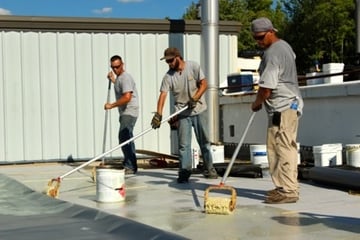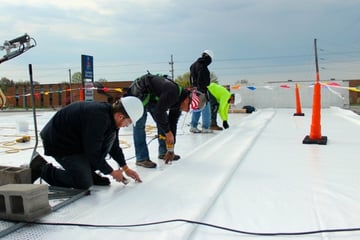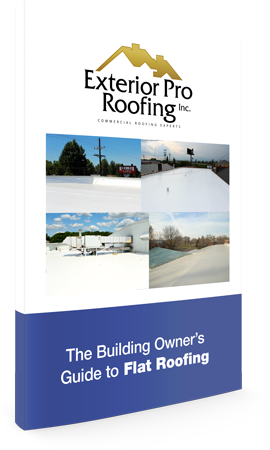Advances in flat roofing technology have let building owners with more choices than ever when deciding which flat roof repair option is right for their building. The development of fabric re-enforced roofing membranes have allowed for an attachment method that eliminates the need to glue down or fully adhere rubberized roofing membranes. The more advanced and stronger way flat roofing membranes can be installed is by using an attachment method that is called mechanically attached meaning to be screwed down.


A few of the many advantages of mechanically attaching a flat roofing membrane over fully adhered are:
- Less labor required to install a flat roofing membrane which equals cost savings
- Faster and less disruptive flat roof repairs and installation
- Saves the material cost of adhesives and cover board
- A flat roof that is mechanically attached will last just as long as flat roof that has been fully adhered
- Flat roofing work can be performed in a much wider temperature rance because the mechanically attached system does not require glue which generally needs temperature in the 50's to adhere correctly
- Mechanically attaching a flat roof vs. fully adhering it can save 50% or more of the total cost of flat roof repair/installation cost
- Great way to reduce flat roof repair cost especially if your flat roof must be torn off due to being saturated with water and/or have bad decking
So what is Mechanically Attached and how does it work?
How can you screw down a membrane on a flat roof that can have holes poked in it and it not leak?
Most folks have a pretty good idea of how you can glue down a rubberized sheet and stick it to a roof but sometimes people have a difficult time envisioning how you can screw down a roofing membrane. To understand how it works we need to remember the fact that flat roofing membranes are stronger than ever because they are re-enforced with a fabric known in the roofing industry as scrim. This woven pattern of threads embedded into the membrane to make it very hard to tear or rip and gives the membrane the strength it needs to be screwed down one edge of a 5' wide roll of material. The screws are installed along with a washer like piece that "bites" into the membrane and a screw and plate are usually installed along every 12" on center long one edge of the flat roofing sheet. Once the roll of material is screwed down along the entire edge the next roll is laid out and allowed to overlap the previous sheet by 6" inches. This amount of over lap not only covers the line of screws and plates but it also leaves enough room for the seam to be made between the two rolls of membrane.
This process is repeated all the way up the flat roof until it is covered with new roofing membrane. Rolls of material are usually 5' wide leaving the membrane fixed to the roof via screws and plates every 5'. The space between the lines of screws and plates lays in place but does not tear or rip because of the strong, re-enforced membrane.
Mechanically attached roofing membranes have been used in Europe since the 1960's and here in the United States since the 70's. It is tested and proven that flat roofing innovations that allow buidling owners and facility managers to cut cost without cutting corners on flat roof repair projects.







